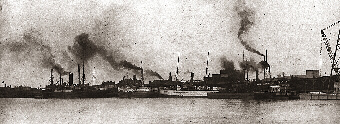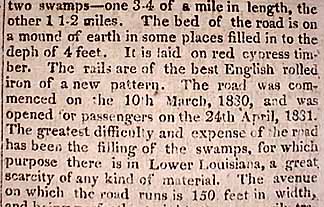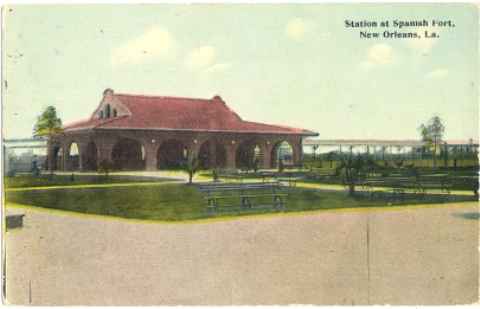1830-1930 ~The Pontchartrain Railroad (The Smoky Mary)
According to the New Orleans Regional Transit Authority,
The Smoky Mary was a streetcar...'Downriver, too, Faubourg Marigny spread beyond
the French Quarter to the most unpopulated Milneburg area, where people enjoyed
picnics and social events on the lakefront. By the 1820s, the Smoky Mary
was a popular streetcar line that moved people from the urban area out to
Milneburg.
Source: New Orleans Regional Transit Authority
Most other sources we've found suggest that the Smoky
Mary/Pontchartrain Railroad was not built until 1830:
The Pontchartrain Railroad was the first railroad west of the Alleghenies and
the first to complete its entire trackage (4.96 miles). Affectionately called
Old Smoky Mary, it was built 1830-31.
Source: href='http://www.tommycrane.com/html/faubmar.html'
http://www.tommycrane.com/html/faubmar.html

According to the New Orleans Historic Collection, the second
oldest railroad in the United States, was established along Elysian Fields in
1830 and extended about five miles to the town of Milneburg on Lake
Pontchartrain.
Source: New Orleans
Historic Collection
~
Although most transportation in antebellum Louisiana was by water, residents also traveled and traded by overland road and railroad. The Pontchartrain Railroad was the second completed in the United States. It began operation in 1831, carrying passengers and goods between the city at the Mississippi River and Lake Pontchartrain at Milneburg.
Source: http://lsm.crt.state.la.us/cabildo/cab9a.htm

The above selection is from the February 21, 1831 issue of the United
States Weekly Telegraph newspaper published in Washington, DC by Duff Green.
The article contains a 1/2 page report about the Pontchartrain Railroad
in New Orleans. The report describes the route and construction of the
Railroad that connected Lake Pontchartrain and the city of New Orleans,
Louisiana. The paper measures 5-1/2' by 9' and contains 32 pages.
~
The railroad connected Lake Pontchartrain to the Vieux Carré, (along present-day Elysian Fields Avenue) and developed Milneburg Port at its terminus. While the port handled cargo from Mobile, the surrounding land soon became a resort area, initially with the Lake House tavern and Washington Hotel. Three bathhouses, other hotels and restaurants, camps, and saloons soon followed. Eventually, the name Milneburg connoted a resort area rather than an industrial port.
The port declined during the Civil War with the suspension of trade with Mobile, Alabama. In 1870, the port declined further when it lost much of its cargo to the New Orleans, Mobile and Chattanooga Railroad. The area evolved into an entertainment district, as the city's passenger train, the Smoky Mary, began carrying more middle-class visitors to the resort. Entertainment included jazz, with Sidney Bechet, Louis Armstrong and Danny Barker performing. Milneburg closed in 1930 after the development of a seawall that displaced several buildings in the resort. The site became the Pontchartrain Beach Amusement Park and the surrounding reclaimed land for the Lake Terrace/Lake Oaks neighborhood.
Source: http://www.new-orleans.la.us/cnoweb/cpc/1999_dist_six.htm

This postcard, from about 1910, was published by C.B.
Mason, of New Orleans, Louisiana. The card pictures the Railroad Station at
Spanish Fort in New Orleans. The description on the back reads, 'Historical
Spanish Fort on the shores of Lake Pontchartrain operated by the New Orleans
Railway
& Light Co., New Orleans, La.'
~
Captain John Grant, who was officially connected with the Pontchartrain
Railroad, running out of New Orleans, for a distance of 5½ miles, which was
opened in 1830, says that on that line the coaches were of every design and
pattern, and the appearance of a train of cars was so unique that in comparison
with a train of the present day it was ludicrous in the extreme.
Source: http://www.railroadextra.com/abrw15.Html



